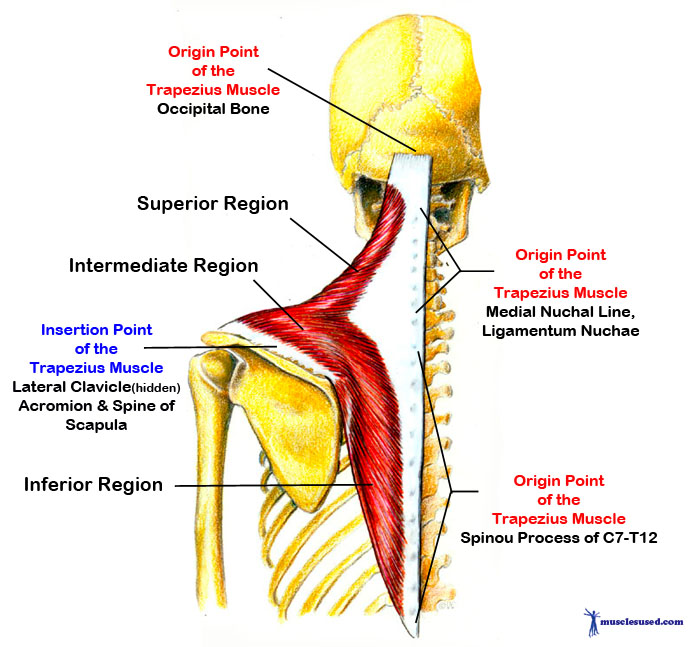
The Trapezius Muscle is located on the upper back of the human torso and it’s main functions are to move the scapula (shoulder blades), head and neck back and sideways and support the arm.
The Trapezius muscle (also known as trapezoids or traps for short) resembles a diamond shaped quadrilateral (trapezoid) and is a large surface muscle that is located in the upper back of the human torso. The Trapezius origin attachment points are from the occipital bone (the bone that forms the back and base of the skull, Ligamentum Nuchae and the Spinous Process of Vertebra C7 to T12. The insertion Attachment points are the Lateral Clavicle and the Acromion and spine of the Scapula. The Trapezius muscle attaches itself to the base of the skull via thin fibrous tissue, to the scapula by by a broad semi-elliptical aponeurosis and to the spinal vertebrae via short tendons. The Trapezius muscles main function is to move the scapula and support the arm.
Three Areas of the Trapezius Muscle:
The trapezius muscle can be divided into three functioning regions:
1.the superior region -descending part or Upper fibers- which functions to support the weight of the arm;
2. the intermediate region-transverse part or middle fibers, which function to draw or pull the scapulae inwards closer to the spine;
3.the inferior region-ascending part or Lower Fibers, which function to rotate and or lower the scapulae.

Here are the three different functioning regions of the Trapezius Muscle as well as the origin ans insertion points
[ad name=”Footer Link”]
Functions of the Trapezius Muscle:
The Trapezius muscle is responsible for the following bodily functions:
- Movement of the scapula in toward the spine
- Movement of the rotation of the scapula to support the topmost part of the upper arm.
- Movement of the Scapula in an up or down direction.
- Movement of the head and neck in a backwards direction
- Movement to the side of the head and neck
- Assisting in breathing- The Trapezius muscle is also considered an accessory breathing muscle meaning it assists the breathing function by slightly enlarging the upper chest region to increase the breathing capacity of the lungs.
It is possible to feel the Trapezius muscles contract by lifting a weight with one outstretched arm in front of the body and, with the free hand, feeling the area between the shoulder and the neck.

This picture gives us a clear view of the Trapezius Muscle. We can distinctively see the Diamond shape that gives us the name for the muscle.
[ad#Page/Post]
Trapezius ,
this website is a very useful web site so thank you a lot of help. 🙂 (lol)
Thanks. very informative
[…] trapezius is the large triangular muscle that covers the back of your neck and shoulders. While you do this […]
[…] Manipulate the trapezius attachment at the base of the skull at the back of the head […]
Very informative-just what I needed in my research for my neck pain. Thank you for your help.
Useful for a bachelor and its upper first diagram make it interesting for more deep study about fascia